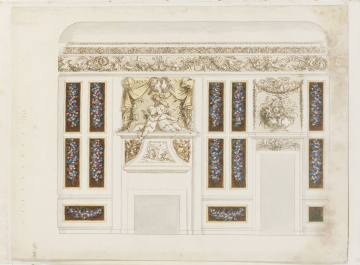
Browse
Reference number
Purpose
Aspect
Scale
Inscribed
Signed and dated
- Undated, but probably c.1693-94
Medium and dimensions
Hand
Watermark
Notes
The imagery of the interior design is of loving union, expressed through the pair of cherubs on the mantel shelf, the pair of doves in a ring of forget-me-nots at the top of the canopy frame, and the pairs of birds and joined rings of flowers in the frieze. The bow, quiver and arrow in the centre of the overmantel represent both the laying down of the arms of battle and cupid's arrow of love. The yellow wash on the overmantel appears to denote a wood colour, while the unwashed areas of relief carving and the cherubs were probably meant to be in limewood. The fire surround and hood-like pedestal with its relief of Venus and Adonis were probably to be in marble.
Although it has been suggested that Nicholas Hawksmoor may have drawn the architectural frame (Thurley, Hampton Court, 2003, p. 179), there is in fact no distinction between the pen drawing of the ruled and freehand lines of the mouldings and the freehand lines of the relief ornament (see, however, 3, below; 110/67). The closet itself was fitted out in 1699-1700 with carved detail identical to that in the King's Little Bedchamber and Writing Closet. In all respects the executed scheme is simpler and lighter, a vast reduction in scale and character on the proposal illustrated by these three drawings. The entablature was changed to a coved cornice, the door has just one moulding above its architrave, and there are no sculptural enrichments beyond the limewood cresting and drops of the overmantel surround. One telling alteration in the executed scheme is to the height of the dado. On the three wall elevations the height of the dado is 3 feet 6 inches, but in the closet itself the dado is over a foot lower, at 2 feet 5 inches. The three door elevations associated with the 1693-94 phase have dados at this lower height of 2 feet 6 inches (above, 6/6, nos. 1-3; 110/57, 55 and 54). This is the approximate height in the fabric of the dado rails in the King's Bedchamber, Little Bedchamber and Writing Closet.
Literature
Level
Exhibition history
Grinling Gibbons and the Art of Carving, Victoria and Albert Museum, London, 22 October 1998 - 24 February 1999
The Genius of Grinling Gibbons: from Journeyman to Kings Carver, Fairfax House, York, 14 April - 14 September 2018
Sir John Soane's collection includes some 30,000 architectural, design and topographical drawings which is a very important resource for scholars worldwide. His was the first architect’s collection to attempt to preserve the best in design for the architectural profession in the future, and it did so by assembling as exemplars surviving drawings by great Renaissance masters and by the leading architects in Britain in the 17th and 18th centuries and his near contemporaries such as Sir William Chambers, Robert Adam and George Dance the Younger. These drawings sit side by side with 9,000 drawings in Soane’s own hand or those of the pupils in his office, covering his early work as a student, his time in Italy and the drawings produced in the course of his architectural practice from 1780 until the 1830s.
Browse (via the vertical menu to the left) and search results for Drawings include a mixture of Concise catalogue records – drawn from an outline list of the collection – and fuller records where drawings have been catalogued in more detail (an ongoing process).

